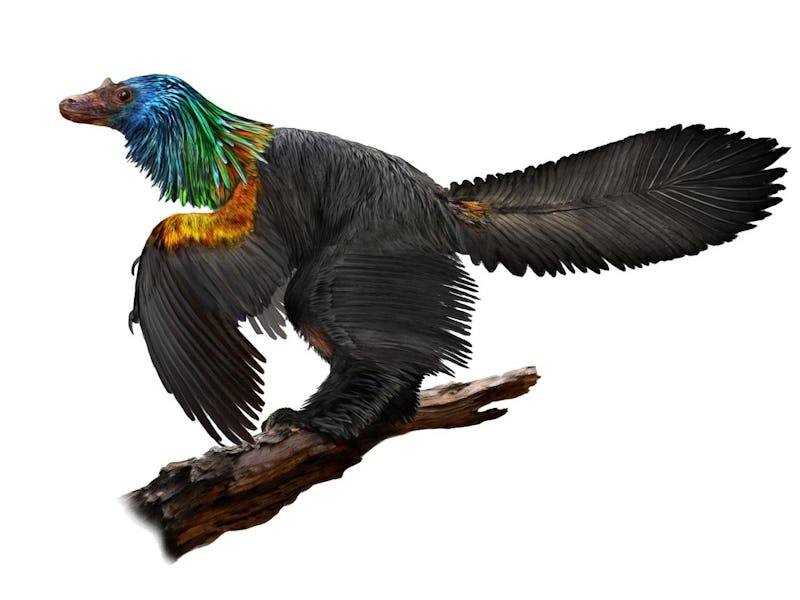Scientists Discovered a Hot Dinosaur with "Rainbow" Feathers from China
If it works for hummingbirds, it must have worked for dinosaurs, right?

A chicken-sized, shaggy-ruffed dinosaur doesn’t really have a whole lot going for it in the looks department. But life finds a way, and a little extra splash of evocative color can do wonders for helping an unwitting creature find a mate. That seems to be the story behind the discovery of a new bird-like dinosaur from northeastern China that lived 161 million years ago. Early analysis points to the dinosaur as having possessed an iridescent, rainbow-like array of feathers adorning its head, neck, and chest. The findings, published Monday in the journal Nature Communications, suggests that the Jurassic Period boasted a much more diverse array of dinosaur species than we could have possibly thought.
The new dinosaur was found as a nearly complete fossil, first discovered by a farmer in the Hebei Province of China. Its incredible preservation is one of the most exciting paleontological finds in recent memory. The dinosaur’s scientific name is Caihong juji, which in Mandarin means “rainbow with the big crest.”
Microscopic analysis indicates that the feathers possess remnants of organelles called melanosomes, which direct pigmentation. Different shaped melanosomes determine what colors the feathers will exhibit, and the Caihong’s feathers contain melanosomes that are similar to today’s hummingbirds that exhibit iridescent feathers.
The long and narrow dinosaur skull is similar to a Velociraptor’s, a shape that is unique among other bird-like dinosaurs. The scale bar is 1 centimeter long.
Scientists cannot reconstruct the exact pattern of the iridescent feathers, but they think rainbow pigmentation is likely.
Although the researchers think the animal was covered in feathers, they are pretty doubtful it could actually fly. The plumage itself seems to be mainly for insulation or a related purpose. The creature was likely a two-legged predator, with a skull, crested head, and teeth reminiscent of a Velociraptor, and it probably hunted small mammals and lizards.
It’s the rainbow colors that have generated the most excitement around this find. Iridescence has no real advantage for modern-day bird species except in mating. The same way a peacock (the male peafowl) uses its ornate, iridescent plumage to attract females, the Caihong’s colorful array of feathers, combined with the crests, is thought to have worked in the same way.
Analyses of nanostructure shape diversity and phylogenetic position of Caihong juji.
“There are crests associated with sexual selection previously known only in earlier dinosaurs, and yet there is also a bird mechanism of signaling or display appearing for the first time,” said Julia Clarke, a professor in the Department of Geological Sciences at the University of Texas, Austin, and a co-author of the new study. “The dinosaur may have a cute nickname in English, Rainbow, but it has serious scientific implications.”
The next step for the research team will be to figure out what were the factors that went into influencing the evolution of Caihong’s look. The team will want to determine to what extent the specie’s traits evolved in tandem with one another, and independently from each other.
If you liked this article, check out this video of a 99 million-year-old dinosaur fossil.